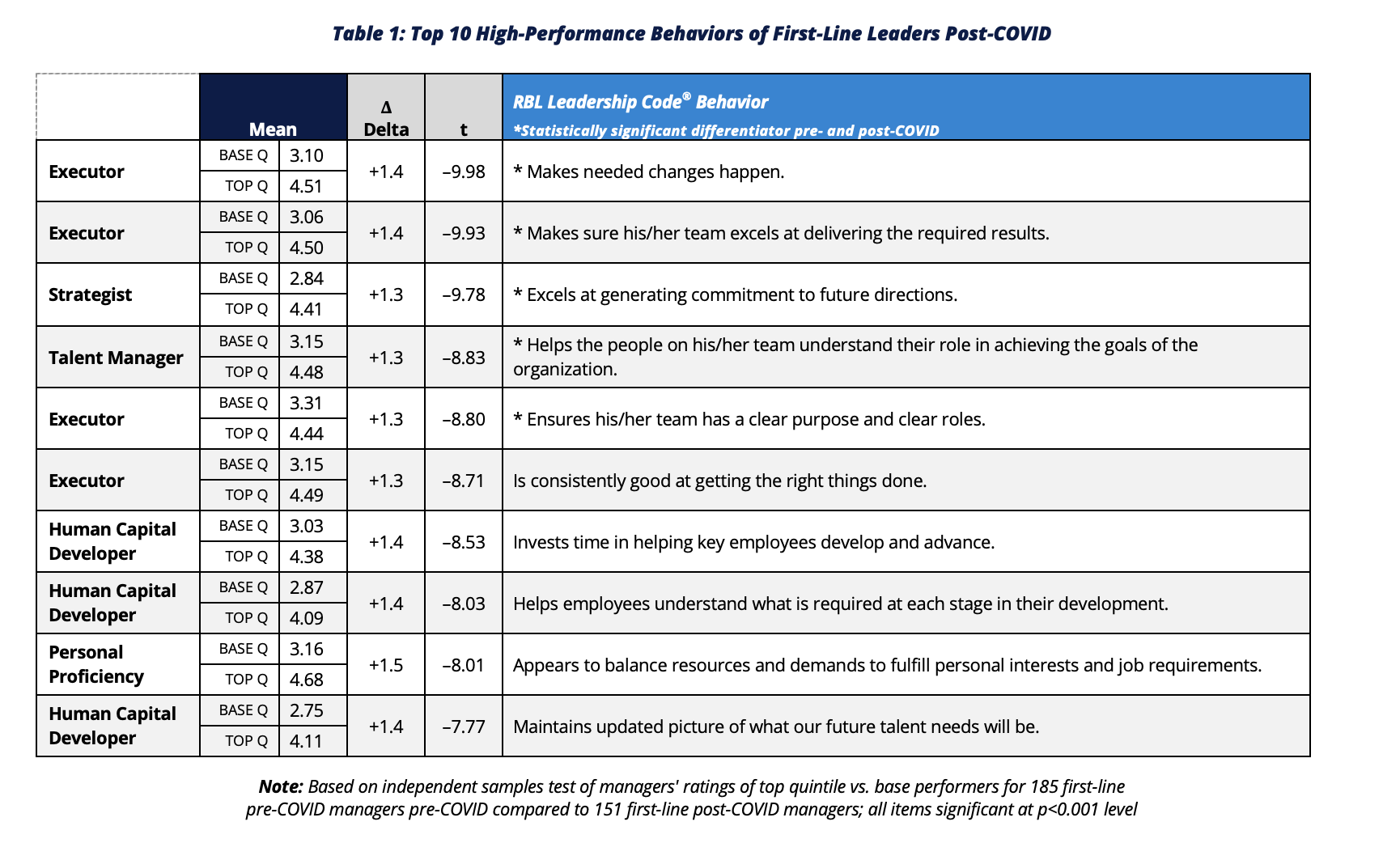What High-Performing First-Line Leaders Are Doing Differently Post-COVID and Why It Matters
Key Takeaways:
- High-performing first-line leaders post-COVID excel in making necessary changes, ensuring team excellence, generating commitment to future directions, and investing in employee development.
- Some behaviors once crucial for high performance, such as incorporating stakeholder expectations and demonstrating exceptional commitment, have become less significant. Instead, there's a focus on discerning priorities, preparing for future talent needs, and maintaining work-life balance.
- Understanding high-performance behaviors can drive stronger business outcomes. Organizations should benchmark leadership capabilities, integrate critical skills into hiring processes, and focus on building effective teams, developing future talent, and enhancing strategic thinking.

What High-Performing First-Line Leaders Are Doing Differently Post-COVID and Why It Matters

High performers increase productivity and drive improved business performance – up to 400% higher. Attracting, hiring, developing, and retaining high-performing first-line leaders begins with recognizing what sets them apart. In this article, we share our leadership-behavior research findings on what high-performing first-line leaders do differently compared to base performers, how that has (and has not) shifted pre- to post-COVID, and why it matters.
Methodology
With a database of more than 2.2 million leadership-behavior ratings from 2009-2023, we analyzed 233,000 ratings of first-line managers from the periods of 2015-2019 (pre-COVID) and 2021-2023 (post-COVID). Each leader in the database was evaluated by their manager, peers, and direct reports on 67 leadership behaviors drawn from five research-based leadership domains (Strategist, Executor, Human Capital Developer, Talent Manager, and Personal Proficiency) in the RBL Leadership Code® as well as four outcome measures weighting each leader’s organizational value contribution.
To gain insight into what differentiates high performers from base performers, we isolated the top-quintile leaders post-COVID (20% of leaders with the highest overall mean outcome scores) and the lowest-scoring leaders post-COVID (20% with the lowest overall mean outcome scores). We next conducted a comparison of means by t-test for each of 67 leadership behaviors to identify which behaviors are unique to the high performers compared to the low performers. We then ran these same analyses to identify what differentiates high performers from low performers pre-COVID. [All findings at significance level p < 0.001].
Our Findings
Table 1 below outlines the top 10 behaviors high-performing first-line leaders post-COVID do significantly better than low-performing leaders post-COVID. Top 10 items are rank-ordered from the top by item with the greatest t value (strongest statistically significant difference in mean score).

Shifts Pre- to Post-COVID
While still important for overall leadership effectiveness, the following five items in Table 2 are pre-COVID high-performance indicators that are no longer top-10 differentiators of high performers. We note that a shift in high-performance indicators does not mean the item is not important for leaders to do; rather, it shows us patterns in how overall leadership behaviors are evolving. In some cases, as the gap narrows between high performers and low performers, it can mean that the overall base is simply overall getting better at this skill and thus there is no longer a significant difference between high and low performers.

High-Performance Behaviors of First-Line Leaders Post-COVID
Post-COVID findings show that today’s high-performing first-line leaders perform significantly higher in the following key areas:
Focusing and Motivating Their Teams on the Right Priorities: Half of the items that predict high-performance have remained the same through all the disruptions of the past five years. Clearly, the ability to effectively lead a group of people to achieve key organizational outcomes is and will continue to be critical to high-performance for first-line leaders. The addition of consistently getting the right things done represents a subtle, but important, shift. Similar to results we found in our other research on first-line leaders, the ability to discern what is most important among a host of competing priorities has increased in importance. We think this likely comes from the increased speed, agility, and efficiency required of first-line leaders to understand external stakeholders’ expectations and help their teams meet them. [We note that our data shows that base performers significantly improved in incorporating expectations of outside stakeholders, including customers, into future goals.]
Grow Talent for Tomorrow: Perhaps the biggest shift pre- to post-COVID in what distinguishes bottom vs. top quintile performers is an increased focus on identifying future talent needs and preparing their team members for the demands of tomorrow’s work. While high-performing first-line managers pre-COVID were those who were able to engage and grow talent for today’s performance, now high-performing first-line managers help their team members understand how they fit into the future. To be high-performing in today’s world, first-line managers must have a point of view about what talent is needed for the future, share that vision with the members of their team in a way that motivates and connects them to the organization, and differentially invest their time in those they see as capable of making the needed shifts.
Modeling Well-Being: While it is clearly still important to deliver results to be seen as high-performing first-line leader, it is significant to note that the demonstration of commitment and energy to the organization pre-COVID has been replaced with the ability to balance personal and work demands. High-performing first-line leaders in today’s world maintain work-life balance rather than turning their lives over to their organizations. They can prioritize what work is most important and are intentional and deliberate about what their team does and what they do personally.
Implications
Understanding what high-performing first-line leaders do differently and better and identifying gaps and opportunities for improvement can help your organization drive stronger business results. We recommend starting with these two actions:
1. Benchmark first-line leadership high-performance capability in your organization. Our high-performer research offers a diagnostic tool for assessing potential performance gaps in your first-line leadership and identifying targeted leadership development opportunities [or we can partner with you to discover the critical value-driving behaviors specific to your organization]. It suggests that development and skills building in these areas are likely areas of opportunity:
- Skills in organizing and leading effective teams
- Skills to build and grow talent for the future
- Skills to understand and prioritize work
2. Incorporate these important skills into hiring and talent review processes. Knowing what skills and behaviors drive high performance can help you improve hiring and drive better business outcomes with your processes. Here are a few questions to reflect on:
- Do your current recruiting and hiring processes identify leaders who not only have good team-building skills but also have demonstrated experience in anticipating future skills that will be needed and growing team members to meet those needs? (We find that many first-line leaders simply do not know how to put talent development into action. They may talk generally about building a “talent pipeline” or “development” but they do not actually have tools or methodologies to make it real for their team and connect their team members to the future.)
- Are hiring, onboarding, and development practices and themes the same as they were a decade ago, or have they been updated to reflect new post-COVID capabilities?
- How well are your leaders able to ability to identify and focus on key priorities?
- Does your organization have clear decision-making protocols that enable speed and agility?
Summary
This exciting new research helps organizations know how to focus development for first-line leaders on the skills that matter most: building and leading teams, growing talent for the future, and building strategic thinking and prioritization skills. Organizations that are successful in building strong first-line leaders will drive higher performance, productivity, engagement, retention, and well-being.
We encourage leaders to both explore what has contributed in their organization to these skills improvements and make a plan to sustain skills and identify areas of opportunity for development.
To discuss how this research can help you build an evidence-based leadership brand and culture that increases value for your stakeholders, contact us to be connected with our leadership development experts.
For more first-line leadership research insights, click here and here. For mid-level leadership research insights, click here. For executive leadership research insights, click here.
i Herman Aguinis and Ernest O’Boyle Jr., “The best and the rest: Revisiting the norm of normality in individual performance,” Personal Psychology, Volume 65, Issue 1, Spring 2012, pp. 79–119, onlinelibrary.wiley.com


